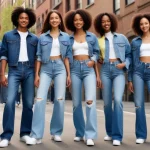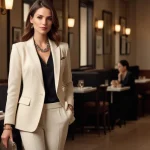Decoding Dress Codes: Your Guide to Event Fashion
Understanding and adhering to various dress codes is paramount for women to project confidence and respect at any event, ensuring appropriate and stylish attire for every occasion.
Have you ever received an invitation and immediately felt a pang of anxiety about the dress code? You’re not alone. Navigating the often-vague world of event attire can be daunting, but with this comprehensive guide, decoding dress codes for women will become an effortless exercise in style and confidence. We’re here to demystify every sartorial expectation, ensuring you always make a memorable, positive impression.
Understanding the basics of dress code interpretation
Before diving into specific dress codes, it’s crucial to grasp the underlying principles of their interpretation. Dress codes are not merely arbitrary rules; they are cultural cues designed to foster a sense of occasion, respect, and unity among attendees. They reflect the formality, purpose, and even the host’s personality for an event. My personal approach has always been to view a dress code as an opportunity to express individuality within a defined framework. It’s about being observant and understanding the unspoken language of fashion.
Consider the event’s location, time of day, and the nature of the celebration. A “cocktail attire” request for an evening gala in a grand ballroom will naturally lean towards more sparkle and sophistication than the same request for a daytime garden party. The venue itself often provides invaluable clues. Is it a five-star hotel, a casual backyard, or a trendy art gallery? Each setting dictates a different level of formality and aesthetic. Always remember that when in doubt, it’s often better to be slightly overdressed than underdressed.
The power of research and context
- Event specifics: Always consider the event’s theme, if any, and the host’s preferences.
- Venue clues: The location can tell you a lot about the expected level of formality.
- Time of day: Evening events generally call for more formal wear than daytime gatherings.
- Guest list: Knowing who else will be attending can offer insights into the overall vibe.
In essence, interpreting a dress code is a blend of practical observation and a touch of intuition. It’s about understanding that a dress code is a guide, not a rigid prison, and allows for personal style to shine through appropriately. By taking these initial steps, you set yourself up for success, ensuring your outfit aligns perfectly with the event’s expectations.
Casual and smart casual: effortless chic
The terms “casual” and “smart casual” often cause the most confusion, precisely because they seem so open-ended. However, there’s a distinct difference, and mastering it can elevate your everyday style. Casual typically means comfortable and relaxed, suitable for informal gatherings like backyard barbecues, picnics, or a relaxed brunch with friends. Think jeans, stylish tops, comfortable skirts, and sneakers or sandals. The key here is comfort without looking disheveled. I often opt for well-fitting denim paired with a fashionable blouse and stylish flats for a casual outing.
Smart casual, on the other hand, elevates the casual look with more polished pieces. It’s a step up from everyday casual but not as formal as business casual. This dress code is perfect for a nice dinner out, a casual office party, or a creative industry networking event. For women, smart casual might involve tailored trousers, a chic skirt, a blazer, stylish blouses, or elegant knitwear. Footwear can range from fashionable loafers to ankle boots or dressier flats. Accessories play a vital role in pulling this look together, adding a touch of sophistication.
Key elements for smart casual success
- Tailored separates: Well-fitting trousers, skirts, or even dark-wash jeans.
- Stylish tops: Blouses, knit tops, or sweaters in quality fabrics.
- Layering pieces: A blazer, cardigan, or stylish jacket can instantly elevate an outfit.
- Polished footwear: Loafers, ankle boots, dressy flats, or block heels.
- Thoughtful accessories: A statement necklace, elegant watch, or a structured handbag.
The beauty of smart casual lies in its versatility. It allows for a great deal of personal expression while maintaining a polished appearance. The goal is to look put-together and intentional, even if the individual pieces are inherently comfortable. It’s about combining comfort with a refined aesthetic, striking the perfect balance between relaxed and elegant.
Business casual and business formal: professional presence
Navigating professional dress codes requires a clear understanding of the expectations in the workplace or at corporate events. Business casual is the most common dress code in many modern offices, striking a balance between professionalism and comfort. For women, this typically means tailored trousers, skirts (knee-length or longer), blouses, sweaters, cardigans, and blazers. Dresses that are appropriate for the office, often in solid colors or subtle patterns, are also excellent choices. Footwear usually includes closed-toe heels, flats, or stylish loafers. The emphasis is on neatness, professionalism, and avoiding anything too revealing or overly casual.
Business formal, however, is a step above and is reserved for more traditional corporate environments, important client meetings, conferences, or formal business dinners. This dress code demands a more conservative and polished approach. Think pantsuits, skirt suits, or professional dresses paired with blazers. Colors should be classic – black, navy, charcoal gray, or subtle pinstripes. Accessories should be understated and elegant, such as a classic watch, simple jewelry, and a structured handbag. Closed-toe heels are almost always expected. The aim is to project authority, credibility, and a serious approach to your professional role.
Distinguishing between business casual and business formal
- Business Casual: Allows for more flexibility in separates, colors, and patterns. Focus on neatness and comfort.
- Business Formal: Emphasizes matching suits, conservative colors, and polished, traditional accessories. High level of professionalism required.
The distinction between these two can sometimes feel subtle, but the impact of choosing the wrong attire can be significant in a professional setting. My rule of thumb is to always consider the industry and the specific context of the event. When in doubt for a business formal event, a classic suit is always a safe and powerful choice. It’s about dressing for success and showing respect for the professional environment.
Cocktail attire: sophisticated celebration
Cocktail attire is arguably one of the most exciting and widely requested dress codes for social events. It strikes a delightful balance between formal and festive, offering ample room for personal style while maintaining an air of sophistication. This dress code is typically requested for evening parties, engagement celebrations, semi-formal weddings, and holiday gatherings. For women, cocktail attire generally means a knee-length, midi, or even ankle-length dress that is elegant and celebratory. Fabrics like silk, satin, lace, or embellished materials are perfect.
While dresses are the most common choice, a chic jumpsuit or a sophisticated skirt and top combination can also be appropriate. The key is to select pieces that feel special and elevated. Don’t shy away from rich colors, subtle sparkle, or interesting textures. Accessories are paramount here: statement jewelry, an elegant clutch, and sophisticated heels are essential to complete the look. Hair and makeup should also reflect the polished nature of the event, adding to the overall glamorous aesthetic. It’s an opportunity to embrace a more dressed-up version of yourself without needing a full-length gown.
Elements of a standout cocktail ensemble
- The dress: Elegant, knee-length to midi, in luxurious fabrics.
- Alternative options: Chic jumpsuits or sophisticated separates.
- Footwear: High heels or elegant dressy flats.
- Accessories: Statement jewelry, a stylish clutch, and perhaps a delicate wrap.
- Grooming: Polished hair and makeup to complement the outfit.
My advice for cocktail attire is to embrace the celebratory spirit. It’s a chance to have fun with fashion, incorporating elements that make you feel glamorous and confident. Yet, always remember that balance is key; if your dress is heavily embellished, keep your accessories a bit more subdued. If your dress is simple, a bold necklace or dazzling earrings can truly elevate the look. It’s about creating a harmonious and sophisticated overall impression.
Black-tie and white-tie: the pinnacle of formality
When an invitation specifies “black-tie” or “white-tie,” it signals the highest levels of formality, demanding a specific and often luxurious approach to dressing. These are rare occasions, typically reserved for grand galas, prestigious award ceremonies, or very formal weddings. Understanding the nuances here is crucial to avoid feeling out of place. Black-tie for women means a formal, floor-length evening gown. The gown should be elegant, sophisticated, and made from high-quality fabrics such as silk, satin, velvet, or chiffon. While black is a classic choice, rich jewel tones or sophisticated metallics are also entirely appropriate.
Accessories for black-tie should be equally refined: fine jewelry (think diamonds, pearls, or elegant statement pieces), a small, elegant clutch, and sophisticated high heels. Hair should be styled, and makeup should be polished and evening-appropriate. The goal is to exude grace and timeless elegance. “Black-tie optional” offers a little more flexibility, allowing for a formal cocktail dress or a very elegant pantsuit if a gown isn’t preferred, but a floor-length gown is still the most traditional and often expected choice.
Distinguishing white-tie from black-tie
- White-Tie: The most formal dress code. For women, this means a full-length ball gown, often with gloves, and very elaborate jewelry. Hair is typically worn up.
- Black-Tie: A formal evening gown is required, floor-length. Fine jewelry and elegant accessories complete the look.
White-tie, the pinnacle of formal dressing, is even rarer. For women, it demands a full-length, often elaborate, ball gown. Gloves are typically worn, and hair is almost always styled in an elegant updo. The jewelry should be exquisite. This is an occasion to embrace true grandeur and theatricality in your sartorial choices. While these codes are strict, they also offer a unique opportunity to immerse yourself in a world of classic glamour and sophistication, transforming you for an unforgettable evening.
The art of accessorizing and personalizing your look
Once you’ve deciphered the core dress code, the real fun begins: accessorizing and infusing your outfit with your unique personality. Accessories are not mere afterthoughts; they are powerful tools that can elevate an outfit, communicate your style, and even transform a simple dress into something extraordinary. My personal philosophy is that the right accessories can make or break an ensemble, and they are where you can truly make an outfit your own without violating the dress code. This applies to everything from jewelry and handbags to shoes and scarves.
For a formal event, a delicate necklace and earrings can add sparkle without overpowering your gown. For a business casual look, a statement watch or a chic belt can add a touch of polish. Handbags also play a crucial role. A structured tote is perfect for business, while an elegant clutch is essential for cocktail or black-tie events. Shoes, too, are more than just functional; they complete the silhouette and can add an unexpected pop of color or texture. I always advise investing in a few versatile pairs of quality shoes that can be dressed up or down.
Tips for impactful accessorizing
- Balance is key: If your outfit is bold, keep accessories simple. If your outfit is simple, use accessories to make a statement.
- Consider the occasion: Fine jewelry for formal events, stylish but practical pieces for casual.
- Invest in versatile pieces: A classic pearl necklace, a good watch, and a few quality handbags.
- Don’t forget your hair and makeup: These are also powerful ‘accessories’ that complete your look.
Ultimately, personalizing your look is about confidence. It’s about choosing pieces that resonate with you and make you feel good, while still respecting the event’s guidelines. Experiment with different combinations, pay attention to details, and let your personality shine through. The most stylish women are those who wear their clothes with an air of ease and authenticity, reflecting their inner self through their thoughtful external presentation.
Navigating ambiguous dress codes and common pitfalls
Sometimes, an invitation’s dress code might be vague, or you might encounter terms that are unfamiliar. This is where a little extra effort and strategic thinking into play. Ambiguous terms like “festive casual” or “creative black-tie” require a bit more interpretation. For “festive casual,” think about the event’s theme (e.g., holiday party) and incorporate cheerful colors, subtle sparkle, or themed accessories into a casual base. “Creative black-tie” suggests taking a traditional black-tie look and adding a unique, fashion-forward twist – perhaps a dramatic silhouette, an unusual fabric, or a bold accessory, always ensuring it remains elegant and formal.
A common pitfall is assuming a dress code is less formal than it actually is. It’s almost always safer to err on the side of being slightly overdressed than underdressed. Being underdressed can make you feel uncomfortable and out of place, whereas being slightly overdressed often signifies respect for the host and the occasion. Another mistake is neglecting proper grooming; even the most exquisite outfit can fall flat if hair is messy or shoes are scuffed. Pay attention to the small details that collectively create a polished look.
Avoiding common dress code mistakes
- Don’t underdress: When in doubt, lean towards more formal.
- Pay attention to grooming: Clean shoes, styled hair, and appropriate makeup are crucial.
- Avoid overly trendy items: Stick to classic silhouettes for formal events.
- Respect cultural norms: Be mindful of specific cultural expectations if applicable.
Finally, if you are truly unsure, don’t hesitate to politely ask the host or someone else attending for clarification. A quick, discreet inquiry can save you from an uncomfortable fashion faux pas. Ultimately, the goal is to feel confident and comfortable in your attire, allowing you to fully enjoy the event without wardrobe worries. By anticipating potential ambiguities and preparing accordingly, you can navigate any dress code with ease and grace.
| Key Dress Code | Brief Description |
|---|---|
| Casual/Smart Casual | Relaxed yet polished for informal gatherings; smart casual adds tailored pieces. |
| Business Attire | Professional and conservative for corporate settings; business formal is stricter. |
| Cocktail Attire | Elegant and festive for semi-formal evening events; often a chic dress or jumpsuit. |
| Black-Tie/White-Tie | The highest level of formality, requiring floor-length gowns and exquisite accessories. |
Frequently asked questions about dress codes
While often used interchangeably, cocktail attire typically implies a slightly more festive and dressy look, usually a knee-length or midi dress. Semi-formal can be a bit broader, sometimes allowing for elegant separates or a dress that’s less overtly celebratory but still polished and appropriate for an evening event.
Traditionally, black-tie for women means a floor-length gown. However, in modern interpretations, a very elegant, tailored pantsuit in a luxurious fabric (like silk or velvet) can be acceptable, especially if it has a formal cut and is paired with appropriate accessories. Always aim for an elevated, sophisticated look.
Footwear should always match the formality of your outfit. For casual, opt for stylish flats or sneakers. Smart casual allows for loafers or ankle boots. Business settings require closed-toe pumps or elegant flats. Cocktail and formal events generally call for heels, ranging from block heels to stilettos, depending on comfort and style.
Festive attire encourages you to embrace the celebratory mood of the event. It often means incorporating brighter colors, metallics, sequins, or unique textures into your outfit. For women, this could be a cocktail dress with some sparkle, a colorful jumpsuit, or elegant separates with festive accessories, while maintaining an appropriate level of formality.
Jeans are generally acceptable only for truly casual events or a “smart casual” dress code if they are dark-wash, well-fitting, and paired with a polished top and accessories. They are never appropriate for business, cocktail, or formal events. When in doubt, it’s always safer to choose tailored trousers or a skirt.
Conclusion
Mastering the art of decoding dress codes is more than just following rules; it’s about understanding the context, respecting the occasion, and confidently expressing your personal style. From the relaxed charm of casual gatherings to the refined elegance of white-tie events, each dress code offers a unique opportunity to present your best self. By paying attention to the details, from the cut of your clothing to the choice of your accessories, you can navigate any event with grace, poise, and an undeniable sense of style. Remember, confidence is your best accessory, and knowing you are perfectly dressed allows that confidence to truly shine.




